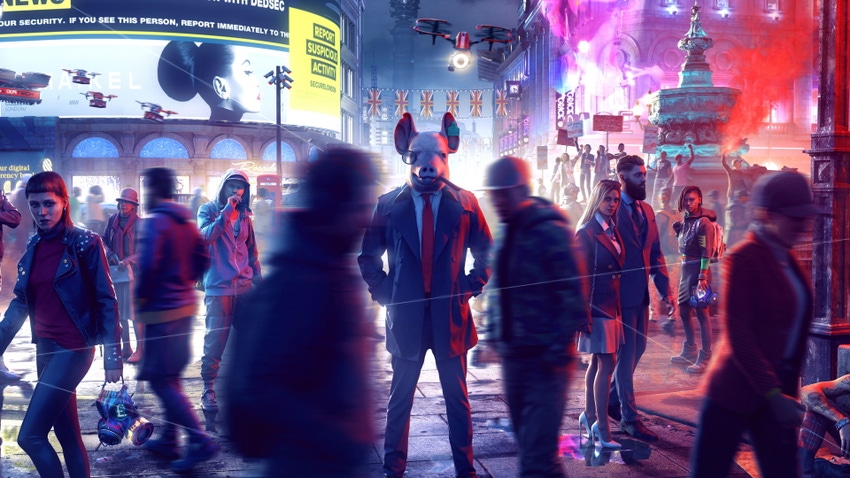.png?width=700&auto=webp&quality=80&disable=upscale)
Ubisoft Toronto's Brandon Hennessy spoke at GDC 2023 about the narrative work that went into Watch Dogs: Legion, and how the game's Play as Anyone mechanic required changes to the narrative team's pipeline.

In 2020’s Watch Dogs Legion, the big "hook" is a feature wherein nearly every NPC is playable and can be recruited into a resistance movement to free London from a techno-dystopia. Similarly, 2021’s Far Cry 6 was built on the premise of becoming a guerrilla fighter on a fictional South American island saving their home from its dictator president, Anton Castillo.
Both of those central premises have to support their respective games at all times, especially since they’re both open-world titles. At GDC 2023, Ubisoft Toronto’s lead writer Heli Kennedy (Far Cry 6) and narrative designer Brandon Hennessy (Watch Dogs Legion) talked about the challenges they faced and methods they used to keep the plot vital and give characters strong arcs in their respective games.
This piece specifically focuses on 2020’s Watch Dogs Legion. Ubisoft Toronto’s work on the narrative design for Far Cry 6 can be read here.
Hennessy was pretty upfront, saying that Legion was unlike anything the Ubisoft Toronto had ever done before, particularly the narrative team. The studio’s previous works, such as Far Cry 5 and Splinter Cell: Blacklist, were relatively straightforward. It was fun to figure out, he said, but also something of a logistical nightmare that it took the narrative team some time to truly figure out.
Since the player can recruit anyone on the street, the team created personas based on a character's age or gender, which would dictate how lines were written in the game’s script. 20 personas were written in total, meaning lines were written in 20 different ways; Hennessy later told me that it was originally 10 before being doubled so as to properly account for all the dialects and accents present in real world London.
Using Watch Dogs 1’s protagonist Aiden Pearce as a point of comparison, Hennessy added that Legion’s players ended up having more authorial power than the game’s writers. “We [the writers] can’t know a character’s age, gender, sexuality, occupation, etc. We can’t know any of these things, ever, which means we can’t mention that in dialogue or build a story around them.”
Early prototypes tried to make this work, but ultimately, the team learned that procedurally generated (or proc-gen) characters couldn’t give them the story they wanted to tell and usually do in big triple-A games with cinematics and voice overs. “Those prototypes have all of the narrative energy of a tug of war where neither side is fully holding the rope,” he said.
While NPCs have various skill sets and traits that make them more viable (or funny) to play than others, those abilities can’t be properly reflected in the script like the first two Watch Dogs games could with their leads. Things get even trickier when NPCs get retired or even die; permadeath is an (optional) feature in Legion, meaning the writers had to treat characters like goldfish who could bite it at any moment.
To get around this, the team created 'Anchors,' characters who cannot be controlled by the player and who have an established presence in the world of Legion’s London. Though there’s a small number of allies who operate as Anchors such as AI Bagley, this role is mainly filled by the game’s antagonists. The Anchors got to operate as actual characters, providing continuity to the world, relaying information to the player, and allowing the proc-gen characters to have common goals with (or against) the Anchor in question. “Introducing a single authored character into a big sea of procedural characters makes them cohere a bit,” continued Hennessy. “The [proc-gens] now get to have a shared memory and common team-wide goals.”
One of Legion’s chief antagonists is a paramilitary leader named Nigel. His existence in the world is allowed to mean something in the context of Legion, even more so if the player manages to recruit members of that organization. “We can let [the characters'] opposition to him drive the story....his goals as the villain are real, concrete things in the world that have story impact. Those goals can motivate our characters, even though the characters themselves lack that kind of specificity.”
The rule for Anchors was that they’d never be playable, which Legion sticks to, beyond the prologue character to teach players the core mechanics. However, post-game DLC like the Bloodlines expansion let players inhabit the roles of Anchors such as Aiden and Watch Dogs 2’s Wrench. Doing so wasn’t an easy return to form, according to Hennessy. not only was it an expensive ask to have Aiden and Wrench’s actors return, the proc-gen characters needed an extra line or two written that addressed those new Anchors.
Heroes aren’t born in Watch Dogs Legion, they’re generated
In the same way that Legion’s procedurally generated characters couldn’t affect the plot, the plot couldn’t affect the characters. The solution was recruitment missions; some NPCs need a personal problem solved before joining the resistance movement. The recruitment missions are completely isolated one-offs and in Hennessy’s words, “the only opportunity to write a story that is actually about them.” With those missions, the goal is for them to stick with the player, even if the mission won’t leave a lasting impact on the character involved.
Every NPC in Watch Dogs Legion has procedurally generated details about them that can be viewed using the series' trademark Profiler. The Profiler was expanded into an entire biography for Legion so as to make them more enticing to the player, including their economic status, age, job, and a fun, odd detail (or two) about them. Speaking to those quirks, Hennessy said the narrative team "did weird on purpose" so they'd stick in players' heads and provide additional context. A trio of NPCs may look the same or all share the same voice, but they'll theoretically have their own different details that allow them to each stand out in their own right. He easily admitted that it wasn’t the same as a fully canon, established character like Aidan, but just as effective.
In previous Ubisoft games, writers have been siloed off to tackle particular story threads. But Legion required Ubisoft Toronto to change its "narrative ownership structure," so the writer of a particular mission would write a base version of the script, which then gets sent off to the persona writers, who created lines based on the 20 character variations. With those variations in mind, the mission owner revises the lines to ensure they maintain their original intent. Essentially, every writer was involved with every character in the game, and you can see how this looks in the color-coded graphic below.
A graphic showing how Watch Dogs: Legion's writing duties were divided among the narrative team.
Since duties were divided evenly and allowed for everyone on the writing team to participate, it meant narrative consistency was still present in Legion, even when writers left the project over the four years development cycle. It also allowed for a "positive and collaborative atmosphere" that Hennessy has since tried to recreate on other projects he's been involved with. He suggested other narrative designers try a similar setup, provided the project in question can support that kind of structure.
After the conference, Hennessy revealed the writing team was built around Legion's central pitch of playing as anyone. When asked about the possibility of having too many writers to properly function, he admitted it would've been troublesome if the structure didn't ensure every writer had at least one persona and set of missions to themselves. "The fact that we were reviewing each other's stuff made it so that it was much more manageable. [...] We're all checking each other’s work first, then it goes up to the leads, and we do polish passes from there," he said. "It was labor intensive, but it also shipped!"
Read more about:
FeaturesAbout the Author(s)
You May Also Like












